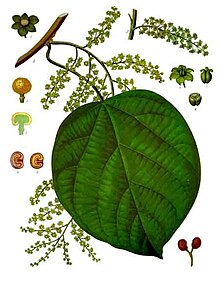| Anamirta cocculus | |
|---|---|

| |
| Indian berry (Anamirta cocculus) | |
| Scientific classification | |
| Kingdom: | Plantae |
| Clade: | Tracheophytes |
| Clade: | Angiosperms |
| Clade: | Eudicots |
| Order: | Ranunculales |
| Family: | Menispermaceae |
| Genus: | Anamirta |
| Species: | A. cocculus |
| Binomial name | |
| Anamirta cocculus (L.) Wight & Arn., 1834 | |
| Synonyms | |
| |
Anamirta cocculus (Marathi: काकमारी) is a Southeast Asian and Indian climbing plant. Its fruit is the source of picrotoxin, a poisonous compound with stimulant properties.
The plant is large-stemmed (up to 10 cm in diameter); the bark is "corky gray" with white wood. The "small, yellowish-white, sweet-scented" flowers vary between 6 and 10 millimeters across; the fruit produced is a drupe, "about 1 cm in diameter when dry".
Chemical substances



The stem and the roots contain quaternary alkaloids, such as berberine, palmatine, magnoflorine and columbamine. The seeds deliver picrotoxin, a sesquiterpene, while the seed shells contain the tertiary alkaloids menispermine and paramenispermine.
Uses
Its crushed seeds are an effective pediculicide (anti-lice) and are also traditionally used to stun fish or as a pesticide. In pharmacology, it is known as Cocculus Indicus.
Although poisonous, hard multum is a preparation made from Cocculus Indicus, etc., once used (by 19th century brewers) to impart a more intoxicating quality ("giddiness") to beer than provided by the alcoholic content alone. Charles Dickens referred to those engaging in such practices as "brewers and beer-sellers of low degree,... who do not understand the wholesome policy of selling wholesome beverage." Although appearing in many homeopathic volumes and at least two brewers' guides, the use of such preparations was outlawed in England, during the mid-19th century, with fines of £500 for sale and £200 for use of the drug.
The wood of the plant is used for fuel and carving.
Common names
The English common names are Indian berry, fishberry, or Levant nut (both referring to the dried fruit, and to the plant by synecdoche) and coca de Levante in Spanish; it is variously known as ligtang, aria (Mindanao), bayati (Tagalog), and variations thereof throughout its natural distribution (the Philippines, East India, Malaysia, and New Guinea).
The name "fishberry" comes from the use of the dried fruit as a method of fishing, in which the fish is "stupified and captured"; this method, however, is considered "unsportsmanlike".
References
- "Anamirta cocculus (L.) Wight & Arn". Plants of the World Online. Royal Botanic Gardens, Kew. 2023. Retrieved 25 March 2023.
- ^ Wilma C. Dichoso, ed. (May–August 2000). "Research Information Series On Ecosystems - Volume 12 No.2" (PDF). Useful Plant Species with Toxic Substance. DENR. Retrieved June 9, 2012.
- ^ R.Verpoorte; et al. (March 1981). "Studies on Indonesian Medicinal Plants V. The Alkaloids of Anamirta cocculus". Journal of Natural Products. 44 (2): 221–224. doi:10.1021/np50014a013.
- Alfred H. Allen (1896). "Bitters of Cocculus Indicus". Commercial Organic Analysis - Vol.III Part III (2nd ed.). Philadelphia: P.Blakiston, Son & Co. p. 167. OCLC 64367571. Retrieved June 9, 2012.
- James A. Duke (September 26, 1995). "Ethnobotanical uses". Dr. Duke's Phytochemical and Ethnobotanical Databases. USDA. Retrieved June 9, 2012.
- ^ E. Harris Ruddock (1874). Text Book of Modern Medicine and Surgery on Homœopathic Principles. London: Homœopathic Publishing Company. p. 833. OCLC 14853471. Retrieved June 9, 2012.
- Webster's Revised Unabridged Dictionary. Springfield, Mass.: G. & C. Merriam Co. 1913. p. 953. Archived from the original on June 27, 2012. Retrieved June 9, 2012.
- ^ Henry Morley, LL.D. (1891). "Appendix (1841-1848): Management of the Food". Early Papers and Some Memories. London: Geo. Routledge & Sons, LTD. p. 373. OCLC 10078708. Retrieved June 9, 2012.
- Charles Dickens (1852). "Constitutional Trials". Household Words - Volume XIV. Leipzig: Bernhard Tauchnitz Jun. p. 299. OCLC 634265325. Retrieved June 9, 2012.
- "Anamirta cocculus". Germplasm Resources Information Network. Agricultural Research Service, United States Department of Agriculture. Retrieved June 9, 2012.
- Lucius E. Sayre; B.S. (1907). "MENISPERMACEÆ - Moonseed Family: 25. Cocculus.". A Manual of Organic Materia Medica and Pharmacognosy (3rd ed.). Philadelphia: P.Blakinston's Son & Co. p. 100. OCLC 5302717. Retrieved June 9, 2012.
| Taxon identifiers | |
|---|---|
| Anamirta cocculus |
|
| Menispermum cocculus | |